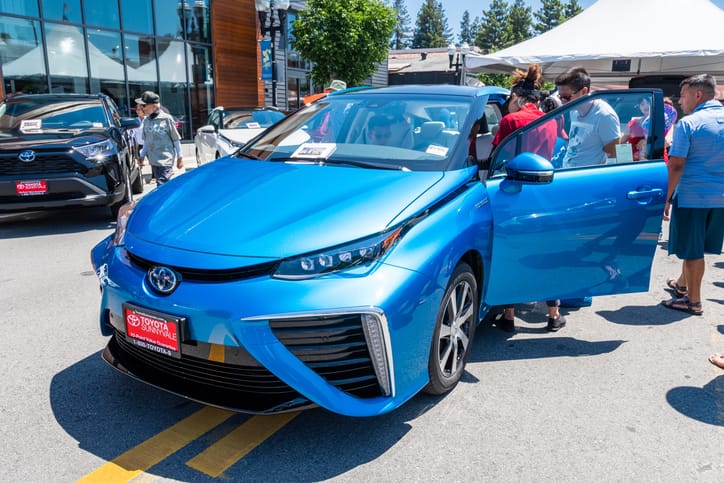The Toyota Mirai: A Glimpse into the Future of Hydrogen Fuel Cell Vehicles

The Toyota Mirai, aptly named after the Japanese word for "future," is a pioneering mid-size car that utilizes hydrogen fuel cell technology. Unveiled in 2014, the Mirai holds the distinction of being the first mass-produced and commercially available hydrogen fuel cell vehicle (FCV). Let's delve deeper into this innovative car and explore its potential to revolutionize the automotive industry.
Powering the Future: How Hydrogen Fuel Cell Technology Works
Unlike conventional gasoline or electric cars, the Toyota Mirai doesn't rely on an internal combustion engine or battery packs. Instead, it harnesses the power of hydrogen fuel cells. Here's a simplified breakdown of the process:
- Hydrogen Fuel Storage: The Mirai stores hydrogen gas in high-pressure tanks.
- Electrochemical Reaction: Hydrogen gas from the tanks flows into the fuel cell stack. Inside the stack, a chemical reaction between hydrogen and oxygen from the air takes place.
- Electricity Generation: This reaction produces electricity, the sole source of power for the Mirai's electric motor.
- Water as the Byproduct: The only emission from the tailpipe is clean water vapor, making the Mirai an eco-friendly transportation option.
This technology offers several advantages:
- Rapid Refueling: Filling up a hydrogen tank takes around 5 minutes, comparable to gasoline vehicles.
- Impressive Range: The 2024 Mirai XLE boasts an estimated EPA range of 402 miles on a single fill, exceeding the range of many electric cars.
- Clean Emissions: With only water vapor as a byproduct, the Mirai significantly reduces greenhouse gas emissions and contributes to cleaner air.

Unveiling the 2024 Toyota Mirai: A Refined and Powerful FCV
The 2024 Mirai marks the second generation of this futuristic car, showcasing significant advancements in design, performance, and technology. Here are some key highlights:
- Sleek and Modern Design: The Mirai adopts a more dynamic and upscale look compared to its predecessor. The flowing lines and sculpted body create a visually appealing presence on the road.
- Powerful Performance: Despite its focus on eco-friendliness, the Mirai doesn't compromise on power. The electric motor generates 182 horsepower, providing a smooth and responsive driving experience.
- Extended Range: The 2024 Mirai XLE offers an estimated driving range of 402 miles, exceeding many electric vehicles and minimizing range anxiety for drivers.
- Advanced Technology: The Mirai incorporates Toyota's latest innovations, including a 12.3-inch touchscreen infotainment system and a comprehensive suite of driver-assistance features.
While the Mirai boasts numerous advantages, it's essential to acknowledge some current limitations:
- Limited Hydrogen Infrastructure: Hydrogen refueling stations are still scarce compared to gas stations, particularly outside of major metropolitan areas. This limited infrastructure can be a significant hurdle for widespread adoption.
- Higher Cost: The Mirai carries a premium price tag compared to gasoline or electric cars. However, government incentives and falling production costs could make FCVs more accessible in the future.

The Road Ahead: Challenges and Opportunities for Hydrogen Fuel Cell Vehicles
The future of hydrogen fuel cell technology hinges on overcoming several key challenges:
- Infrastructure Development: Expanding the network of hydrogen refueling stations is crucial for wider adoption of FCVs. Collaboration between governments, energy companies, and car manufacturers is essential for building a robust hydrogen infrastructure.
- Cost Reduction: Technological advancements and economies of scale should drive down the production costs of FCVs, making them more competitive with traditional gasoline and electric vehicles.
- Renewable Hydrogen Production: Currently, most hydrogen production relies on fossil fuels. Shifting towards renewable energy sources like electrolysis to generate clean hydrogen is critical for maximizing the environmental benefits of FCVs.
Despite these challenges, hydrogen fuel cell technology offers several significant opportunities:
- Clean Transportation: FCVs have the potential to revolutionize transportation by providing a clean and sustainable alternative to gasoline-powered vehicles.
- Energy Security: Hydrogen can be produced domestically from various sources, reducing dependence on foreign oil.
- Job Creation: The development and expansion of hydrogen infrastructure can create new jobs in various sectors.
Conclusion: The Toyota Mirai – A Beacon of Hope for a Sustainable Future
The Toyota Mirai serves as a testament to the potential of hydrogen fuel cell technology. With its impressive range, clean emissions, and rapid refueling capabilities, the Mirai offers a glimpse into a future where sustainable transportation becomes a reality. While challenges remain, ongoing advancements in infrastructure, production costs, and renewable hydrogen generation pave the way for a more sustainable future powered by hydrogen.
